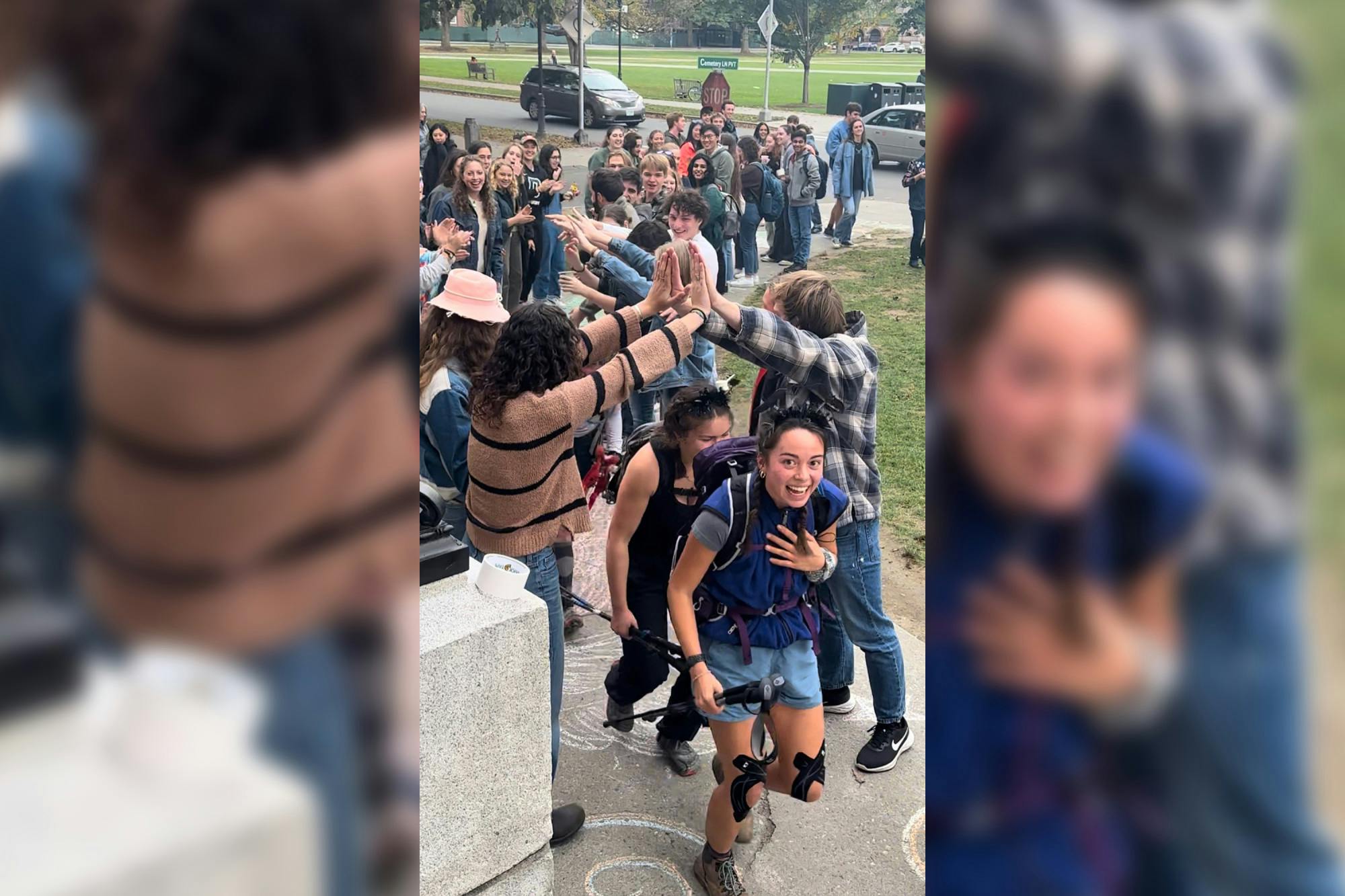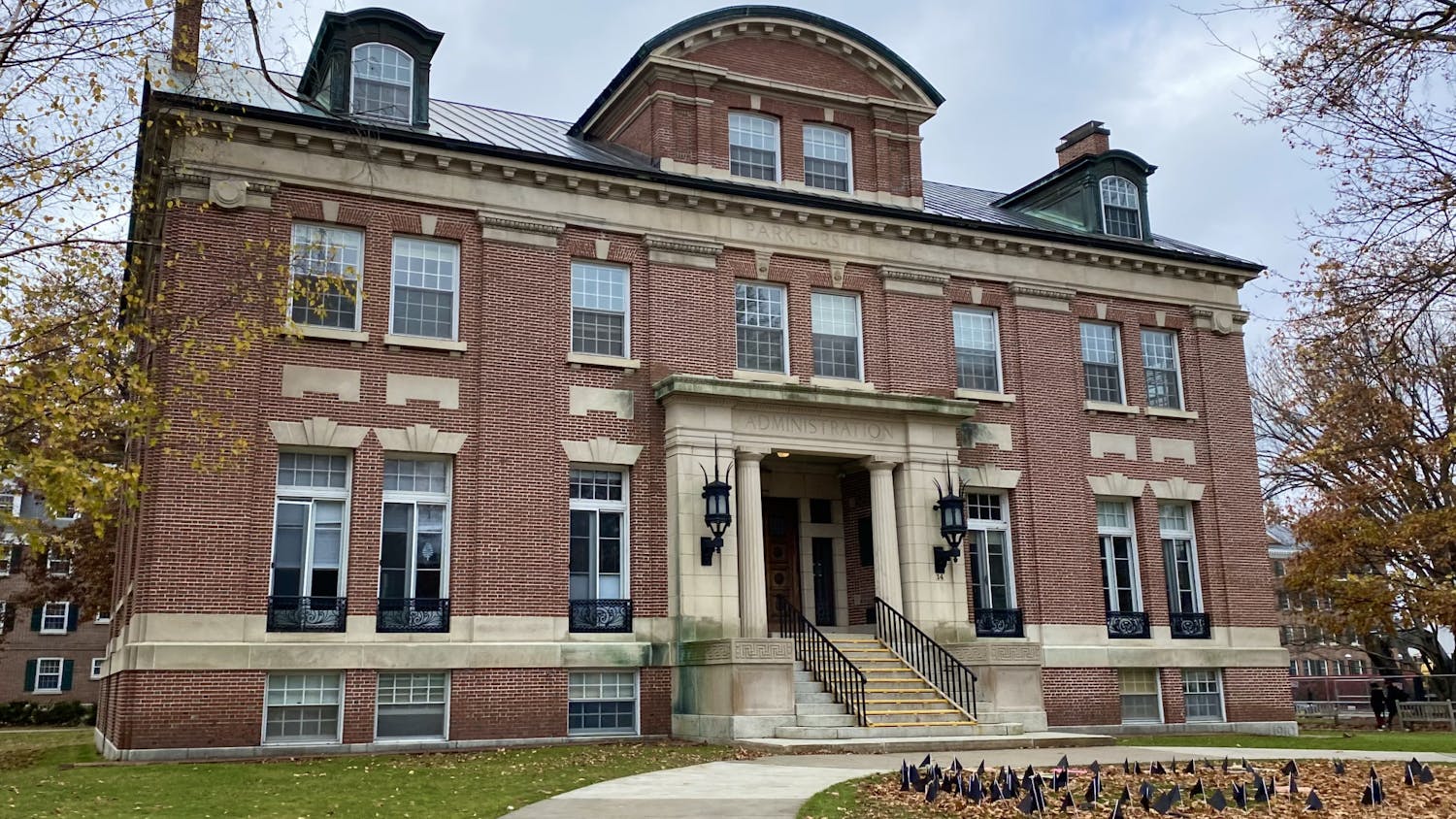This article is featured in the 2023 Homecoming special issue.
From Oct. 13 to 14, 32 hikers attempted the Dartmouth Outing Club Fifty, a 53.5-mile hike from Moosilauke Ravine Lodge to Hanover that takes place in the fall and summer, according to fall logistics coordinator Jack Nelson ’25. Over 70 students will support the hikers at five stations along their route, providing food, first aid and encouragement, he added.
This year, the Fifty started on the morning of Friday, Oct. 13, and hikers had to arrive back in Hanover before the sunset on Saturday evening. According to Joseph Earles ’23 — a former hiker of the Fifty and hiker coordinator for the fall term— the stretch of the Appalachian Trail hiked on the Fifty is all maintained by the DOC, and 21 of the 32 participants completed the hike this year. However, the Fifty is a long-standing tradition that dates back 105 years.
The first iteration of The Fifty began in 1920 whenSherman Adams — a member of the Class of 1920 and co-founder of the Cabin and Trail subclub of the DOC — completed an 83-mile hike on Memorial Day.The route originally followed a line of DOC cabins from Hanover to Franconia Notch State Park, close to part of the Appalachian Trail, according to program coordinator Kellen Appleton ’20. Adams hiked his version of the Fifty in a record 24 hours, according to reporting by the New York Times.
Adams’s first trek evolved into the mileage contests and “Long Walks” of the 1920s, according to Appleton. She added that students in the DOC would organize support stations for those who attempted to set personal records of their longest day hikes.
From 1949 to 1953, Adams served as the governor of New Hampshire and helped campaign for former U.S. President Dwight Eisenhower, who was a presidential candidate at the time, across the country. After Eisenhower’s election, Adams transitioned to serve as the Chief of Staff in the White House, according to Dartmouth Alumni Magazine.
Acoording to Ed McNierney ’80, the closest version of the modern Fifty originated in the late 1960s and was known as the “trail walk.” He added that the trail walk involved the New Hampshire portion of the Appalachian Trail between Moosilauke and Hanover, which students hiked solo or in small groups in both directions, with minimal support.
Cabin and Trail was the first sub-club within the DOC and was primarily dedicated to hiking and backpacking. In the late 1970s, CnT members were elected to join the club at the end of each term, according to McNierney. He was voted in at the end of his freshman fall, quickly becoming “very active” in the DOC, and serving on the CnT and Winter Sports Club councils.
“I had probably spent more time in Cabin and Trail than in the classroom,” McNierney said.
McNierney hiked the Fifty in the fall of 1977, from Hanover to Moosilauke. “I arrived at the beginning of a square dance and celebrated all my walking by dancing for a few hours and just having fun,” he said.
Carrie Bjerke ’91 was on support Croo — the volunteers responsible for supporting hikers along the route of the hike — for the Fifty during her time at Dartmouth , making waffles for hikers at the Atwell Hill station.
“The Fifty ended at the Lodge, so the challenge was to get there in time for dinner and with enough spring in your step to still be able to contra dance that night,” she said.
Hikers and supporters of the Fifty today come from “much bigger crowds than just the DOC,” Earles said.
“I think because of the way it’s supported, the Fifty is more accessible for the average person,” Earles said. “If you’re hiking 50 miles by yourself, you’re carrying 30 pounds on your pack, as opposed to nowadays, it’s physically a lot easier with support.”
Earles said the five support stations along the trail make the Fifty “kind of like a party,” with hot food, music and a unique theme. The hikers only stay for roughly 15 minutes, but get “physically and emotionally cared for,” Earles added.
Nelson applied to be the logistics coordinator of the Fifty after his “incredible” experience supporting the Fifty during his sophomore summer.
“I supported the Jacobs Brook Station … and it was incredible. [The hikers] didn’t come through until 11 at night, [and then they came in groups until] 1 a.m.,” he said. “To just be in the middle of nowhere and then to suddenly see one headlamp in the distance … and to know that they’ve already hiked a marathon and still have another marathon to do is pretty incredible.”
Although the logistics of the Fifty have drastically evolved over the past 100 years, Earles said the event continues to reflect the spirit of the DOC and the larger Dartmouth community. He added one of his favorite aspects of the Fifty is how “silly” it is.
“I think it reflects a collaborative atmosphere of people trying to do insane shit, or high achieving things at Dartmouth,” Earles said. “I also really think the support stations make the Fifty — they show people’s desire to support each other, but also bring fun to the outdoors in maybe nontraditional ways.”
McNierney’s experiences with the DOC in the late 70s reflect a similar sentiment. When he attended Dartmouth, there was a “real interest in challenging activities,” such as hiking the Presidential Range in the winter or trying to climb all “4,000 footers.”
“We used to say that a particular activity was ‘hardcore,” McNierney said. “And if you did something that was hardcore, it meant that if you had gotten hurt, we would have said it was stupid, but you didn’t get hurt, so it was hardcore.”
McNierney noted that there were also “occasional variations” of the Fifty, such as the effort by Gary Clohan ’77, who chose to bike the trip.
“This was long before mountain bikes, and he ended up carrying the bike much of the way,” he said. “I remember hearing that [Clohan] encountered [a few] Appalachian Trail hikers … who [were] awakened in the morning by some guy carrying his bike over the top of Smarts Mountain. There were lots of odd things like that, but I think it was sort of the nature of the trip, it was this unsupported, do-it-yourself.”
Although most of the funding for the Fifty comes from hikers themselves, the Fifty is also financially supported by the DOC, according to Earles. Nelson said that it “would not be possible” to organize the Fifty without all of the volunteer supporters and the people in the Dartmouth Outdoor Programming office who work to make it happen.
Most years, eight teams of four students are selected for the chance to hike the Fifty, Nelson explained, with another 75 students supporting. This fall there was “especially high demand” to be involved with the Fifty, as 180 students applied to hike and almost 200 volunteered to support, according to Nelson.
“Huge shout-out to the people who do trail maintenance throughout the term because it’s hard work that’s enjoyed by not just by those hiking the Fifty, but also thousands of Appalachian Trail through-hikers, even dozens of thousands of just day hikers who enjoy the trail that Dartmouth maintains,” Nelson said.




